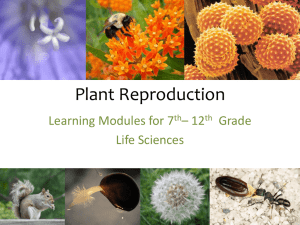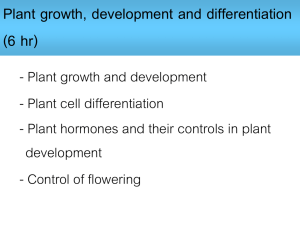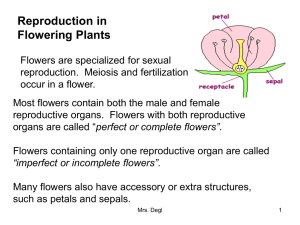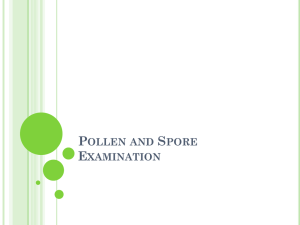File - LC Biology 2012-2013
advertisement
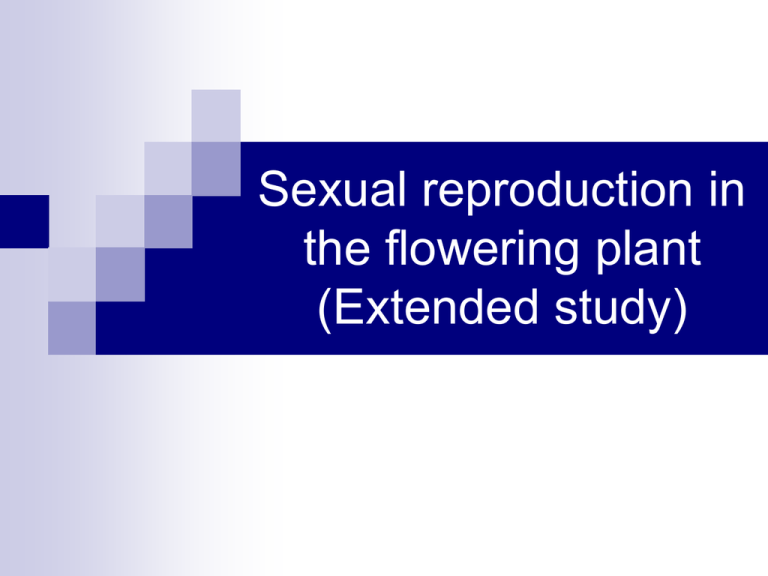
Sexual reproduction in the flowering plant (Extended study) Learning Objectives Outline pollen grain development from microspore mother cells Outline embryonic sac development Pollen Grain development Pollen grain development An anther consists of four chambers called pollen sacs Pollen Sac Each pollen sac is protected by a fibrous layer Inside the fibrous layer is the tapetum – a food store that supplies energy for cell divisions in the pollen sac Fibrous Layer Tapetum Pollen Fibrous Layer Tapetum Pollen Pollen Grain development Microspore mother cells (2n) are located in the pollen sacs They are diploid They divide by meiosis to produce a group of four haploid cells called a tetrad Each tetrad breaks up to form four separate haploid pollen grains Pollen Grain development Microspore mother cell (2n) Tetrad of pollen Meiosis Separation Pollen Grains (n) Pollen Grain development Pollen grains divide by mitosis producing two haploid nuclei: nucleus – forms the pollen tube Generative nucleus – form the male gametes Tube Mitosis Tube nucleus Generative nucleus Pollen Grain development When pollen grains have matured the walls of the anther dry and split Pollen grains are then exposed and are ready for pollination Pollen Grain development After pollination the generative nucleus (n) divides by mitosis to form two sperm nuclei (n) These will each play a role in double fertilisation Pollen Grain development Learning Check How many pollen sacs does an anther have? What form of cell division takes place in a pollen mother cell? What is the group of four pollen cells called before they separate? What form of cell division takes place to produce the generative nucleus and tube nucleus? Embryo sac development Each ovary contains one or more ovules An ovary has two walls called integuments Between the integuments is a small opening (micropyle) through which a pollen tube can enter. The nucellus provides nutrients for growth in the ovule Integuments micropyle nucellus Megaspore mother cell (2n) One cell in the ovule, the megaspore mother cell (2n) divides by meiosis to form four haploid cells Three of these cells disintegrate The remaining cell is called the embryosac. Meiosis Embryo sac (n) The nucleus of the embryo sac (n) divides by mitosis three times forming eight haploid nuclei These are still contained within the embryo sac Five of these nuclei will later disintegrate The remaining three are the gametes Gametes Polar nuclei (n) Gamete – Egg cell (2n) Two of these form the polar nuclei in the embryo sac The remaining female gamete forms an egg cell Megaspore mother cell (2n) Meiosis Embryo sac (n) Mitosis (3 times) Polar nuclei Egg cell Recall Pollen grains divide by mitosis producing two haploid nuclei: Tube nucleus – forms the pollen tube Generative nucleus – form the male gametes Events leading to fertilisation Once pollination has occurred the pollen tube nucleus forms the pollen tube which moves down the style to the ovule in the ovary The tube nucleus moves towards chemicals released from the ovule (chemotropism) Events leading to fertilisation The generative nucleus (n) divides by mitosis as it moves down the pollen tube Two haploid sperm nuclei result These are the male gametes On reaching the embryo sac a double fertilisation will take place Fertilisation One sperm nucleus (n) fuses with the egg nucleus (n) to form a diploid zygote. This will develop into an embryo The second sperm nucleus (n) joins with the two polar nuclei (2n) forming a triploid (3n) endosperm nucleus Syllabus Depth of treatment Pollen grain development from microspore mother cells: meiotic division, mitotic division, generative and tube nuclei production, formation of pollen grain Depth of treatment Embryo sac development: megaspore mother cell, meiotic division, cell disintegration, mitotic division in the production of eight cells of the embryo sac, one of which is the egg cell.


